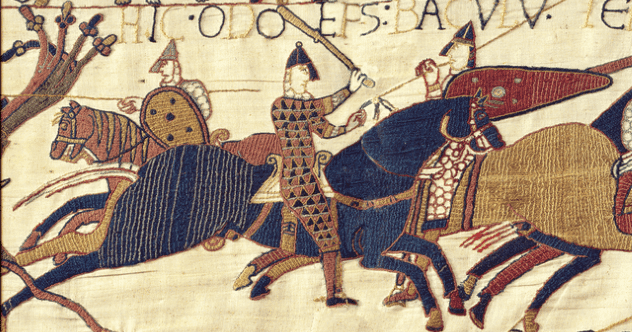As the Roman Empire declined in the 4th century, mass migrations swept across Europe. Germanic tribes began arriving in Britain after Roman forces withdrew in AD 410. Over the next 600 years, a unique Anglo-Saxon culture blossomed in England. However, this era remains relatively obscure. Unlike the Romans, who left behind written records and stone structures, the Anglo-Saxons mainly built with wood, leaving fewer lasting remnants.
Due to limited historical sources, the Anglo-Saxon period was once dubbed the Dark Ages. Yet, a closer examination of surviving artifacts reveals the impressive nature of this time. Through these treasures, we gain insight into the lives, artistry, and beliefs of the Anglo-Saxons.
Here are ten remarkable treasures of the Anglo-Saxons that have been recovered, offering glimpses into their fascinating world.
10. Sutton Hoo Helmet
The 1939 Sutton Hoo excavations in England caused a sensation. Digging into a large mound revealed the remains of a burial. Previous mounds had been looted, so expectations were low. Instead, archaeologists discovered a spectacular ship burial filled with Anglo-Saxon artifacts.
Among gold and silver brooches and other grave goods, they found hundreds of rusty fragments. Painstaking work pieced these together to reveal a rare Anglo-Saxon helmet. Its brilliant craftsmanship suggests it belonged to King Raedwald of East Anglia.
The helmet features motifs typical of Anglo-Saxon art. A golden dragon forms the crest, with panels suggesting extended wings. Metalwork plaques depict humans, warriors on horseback, and deities. The face plate, covering the wearer’s face, is particularly significant, offering insight into how the Anglo-Saxons wished to be seen. [1]
9. Staffordshire Hoard
Metal detectorists dream of finding treasure. In 2009, Terry Herbert realized this dream in a Staffordshire field. Within days, he unearthed over 200 gold fragments. Archaeologists then excavated a total of 1,500 valuable Anglo-Saxon art items.
The hoard included over 11 pounds (5 kilograms) of gold, 3 pounds (1.4 kilograms) of silver, and thousands of carved garnets. Its value lies in revealing the Anglo-Saxon world. Most items were military, like sword pommels and helmet parts. Some pieces with Anglo-Saxon images connect us to the past.
The gold work features intricate details created with fine wires delicately soldered on. Garnets likely came from as far as India or Central Europe, proving Anglo-Saxon Britain was connected to the wider world. [2]
8. Anglo-Saxon Glass
Roman glasswork was impressive, with diverse colors and complex forms. After the Romans left Britain, glass became less common under the Anglo-Saxons, mainly because key ingredients were sourced from Egypt by the Romans. However, the Anglo-Saxons still produced glass items.
Anglo-Saxon graves often contain glass beads, typically found with female skeletons and likely worn on strings. These beads feature vivid colors and intricate patterns. While requiring less material than larger objects, they are still beautiful.
The Anglo-Saxons also created impressive glasswork, including beakers and drinking horns found as grave goods. Over time, Anglo-Saxon glass-blowers enhanced their skills, producing detailed works with improved quality. [3]
7. Lindisfarne Gospels
Books from Anglo-Saxon England are exceptionally rare. Among the 1,000 surviving, the Lindisfarne Gospels are paramount. Lindisfarne, a small island on England’s northeast coast, was a key site for Christianity and learning. In the early 8th century, a monk named Eadfrith copied a Latin version of the four gospels, creating an artistic masterpiece.
The Lindisfarne Gospels burst with color, using reds, blues, greens, and yellows to illuminate the pages. Gold flecks shimmer throughout. The decoration is richly detailed; a single page can contain over 10,000 red dots. The artistic style blends Roman, Celtic, and Anglo-Saxon motifs. Such books aided Britain’s conversion to Christianity, symbolizing the power of the new God.
In the 10th century, a priest named Aldred translated the text into Old English, writing between the lines of the Latin original. This is the earliest known Bible translation into English. [4]
6. Brooches
Brooches were essential for Anglo-Saxon attire, as they lacked zippers. While poorer individuals used simple bone or metal pins, wealthier people, especially women, favored ornate brooches made of gold, silver, and decorative stones.
The brooch front concealed the pin and hinge, serving as a canvas for artistry, fashion, and displays of power. Some discovered brooches seem large today, but they effectively showcased the wearer’s wealth. The Kinston brooch, almost 3 inches (7.6 centimeters) in diameter, features filigree gold work, garnets, blue enamel, and pearls.
Owners valued these brooches. One, owned by a woman named Ædwen, included an inscription invoking a curse on anyone who took it without her permission. [5]
5. Gold and Garnets
Garnets aren’t the most fashionable gemstones today due to their affordability and commonality. Their translucent red color has always been prized. For Anglo-Saxons, garnets were the primary gem, adorning metalwork, swords, helmets, and brooches, signifying wealth and status.
Instead of faceting gems, Anglo-Saxons thinly sliced and carved them into shapes that fit closely together. Small gold walls separated each stone. Achieving the correct size and shape for these tiny garnets was crucial and done by hand.
To enhance the garnets’ appearance, they were often backed with gold foil to reflect sunlight, making them glimmer. This foil was sometimes patterned to boost their beauty further. [6]
4. Anglo-Saxon Sword
The Anglo-Saxon world consisted of frequent warfare between rival kings. Many treasure hoards likely contain items taken from the dead after battles, buried and never reclaimed. Given the importance of weapons, Anglo-Saxon warriors crafted them to reflect their status.
Sword pommels were often covered in gold, silver, and garnets. Treasure hoards commonly include these valuable pommels hacked off swords after battle losses.
The sword blades were also feats of metalwork. Anglo-Saxon smiths couldn’t produce iron ingots as we do today. Their furnaces created small iron nuggets that had to be forge-welded together to create a long blade, requiring immense skill to prevent shattering. [7]
3. Bayeux Tapestry
The Anglo-Saxon period ended in 1066 when William the Conqueror from Normandy seized the throne. Ironically, one of the last great pieces of Anglo-Saxon art celebrates the end of this era. The Bayeux Tapestry, actually an embroidery, depicts the Norman conquest across 230 feet (70 meters) of fabric.
Commissioned by King William’s half-brother, Bishop Odo, shortly after the Battle of Hastings, the tapestry was made in England by Anglo-Saxon needleworkers. The dyes, stitches, and textual evidence indicate Anglo-Saxon influence.
The tapestry illustrates key conquest moments, from King Edward the Confessor’s death to William’s sail from France and King Harold’s fall. The image of King Harold with an arrow in his eye popularized the notion of his death. The tapestry also features the earliest depiction of Halley’s Comet. [2]
2. The Franks Casket
Carved bone and ivory rarely survive well, unlike metal objects. The survival of the Franks Casket—now in the British Museum—is remarkable. Made from whalebone in 8th-century northern England, it reveals the ornate nature of the Anglo-Saxon world.
Likely crafted in a monastery, it depicts Anglo-Saxon folklore, myths, the birth of Romulus and Remus, and various animals, each carved in exquisite detail. The casket features inscriptions in Old English runes and Latin.
The casket had a checkered history, ending up in a French church. It was looted during the French Revolution and repurposed as a sewing box. Silver fittings were removed and traded for a ring. Most panels reside in the British Museum, while some were later found in a drawer and are now in a French museum. [9]
1. Alfred Jewel
Alfred the Great, king of the West Saxons from AD 871–886, later styled himself king of the Anglo-Saxons and is the only English monarch to receive the title “the Great.” His reign involved conflicts with the Vikings, but he also supported scholars and learning. The 1693 discovery of a jewel reinforced this reputation.
The Alfred Jewel features gold, rock crystal, and enamel. Beneath the polished crystal is an image of a man with holy symbols. The figure’s identity is unclear, but the jewel proclaims its maker: “Alfred had me made” in Old English.
The jewel’s purpose might be known. A socket at the bottom likely held a wooden stick, making it a pointer, or aestal, to indicate words on a page. Alfred had fifty such pointers made when sending copies of a book from the pope to bishops, instructing that the pointer should stay with the book. Since we have the jewel but not the book, someone disobeyed this order. [10]
These ten treasures offer a window into the Anglo-Saxon world, showcasing their artistry, beliefs, and connections to the broader world. From intricately designed helmets to religious artifacts and personal adornments, each piece tells a unique story.
Which of these Anglo-Saxon treasures fascinates you the most? Leave a comment below!










